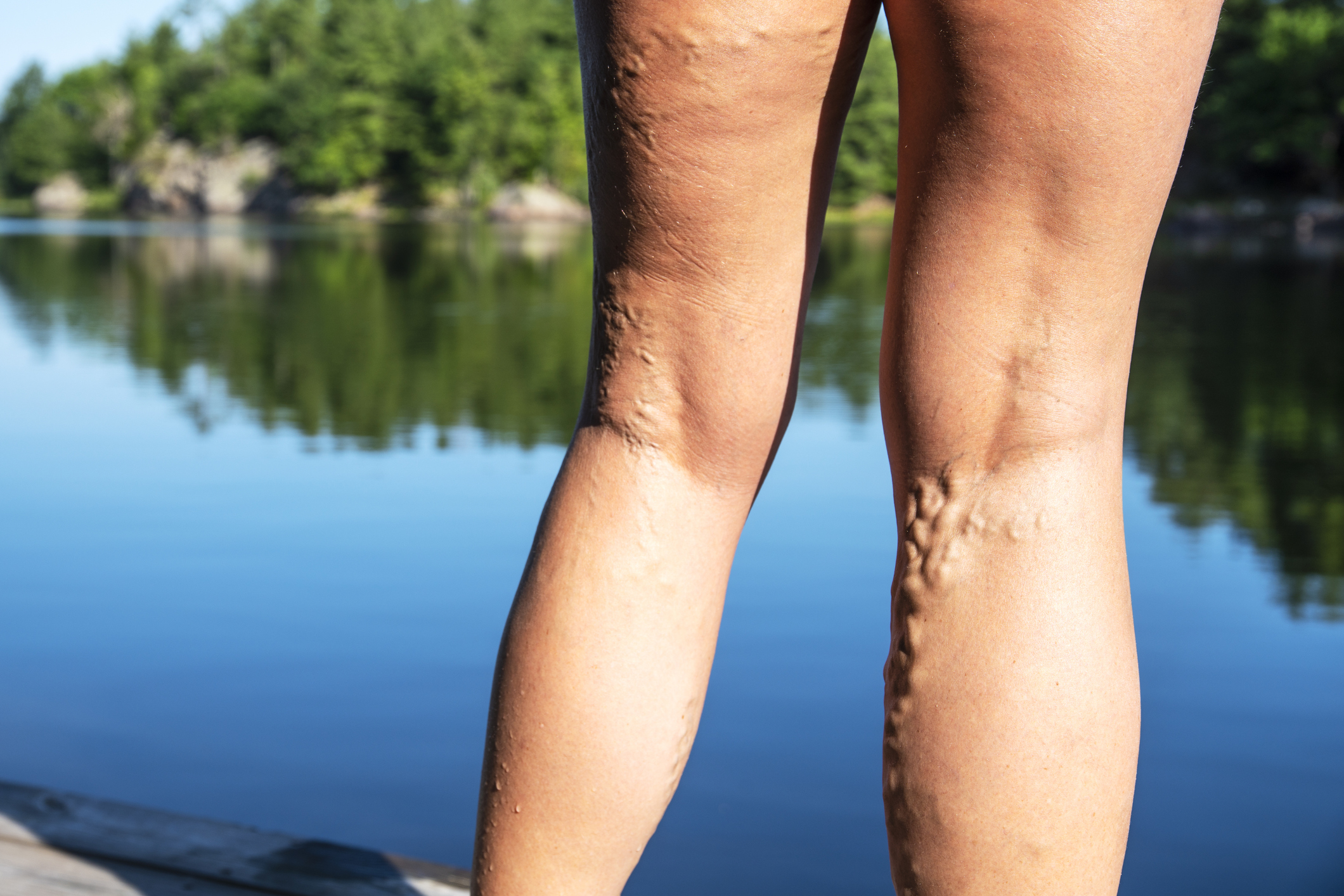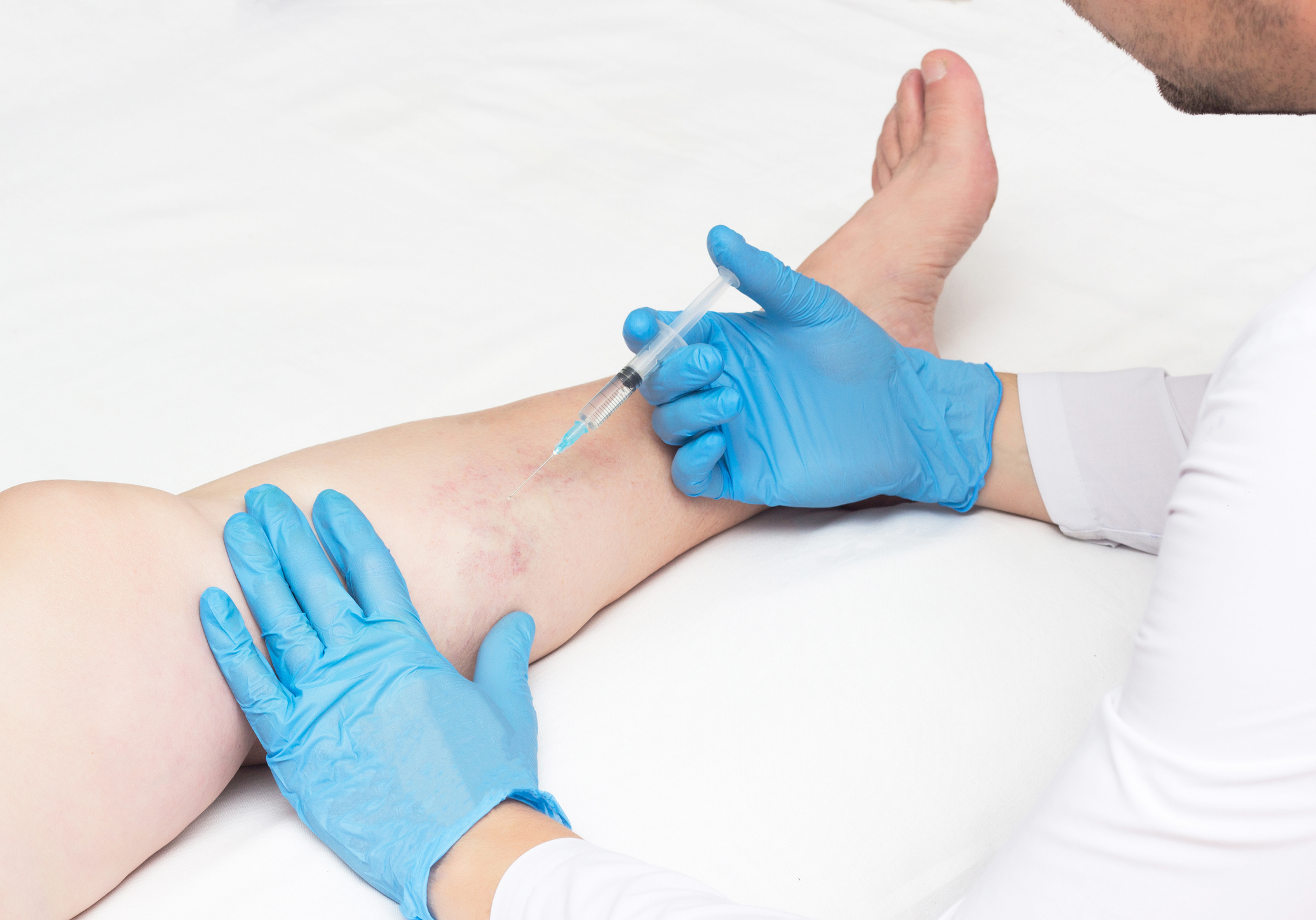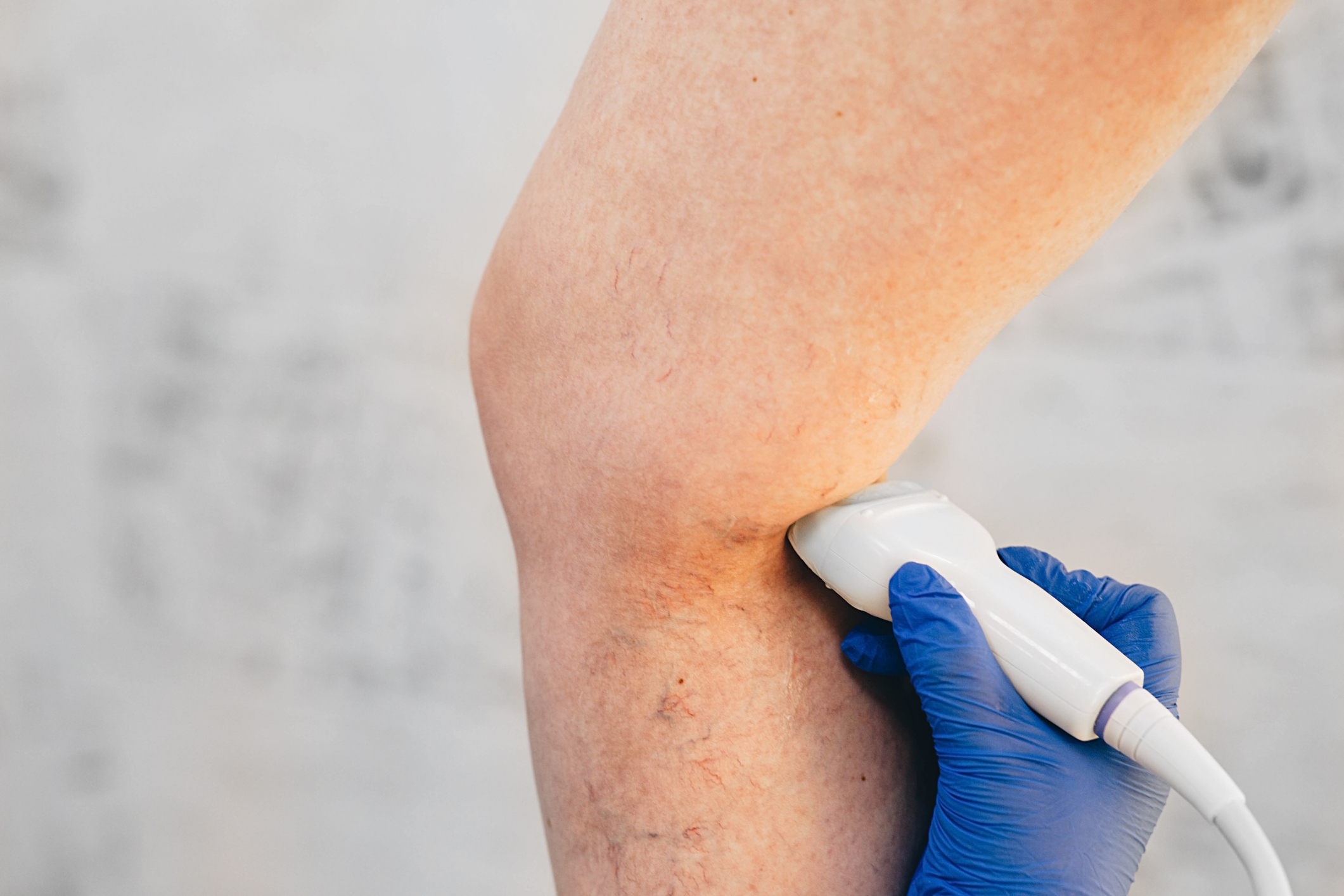Factors to Consider When Contemplating Vein Treatment Options
More than 30 percent of our population has some form of vein disease. When you factor in spider veins, that percentage increases dramatically. Although most people understand that varicose veins will not resolve without treatment, many put off enlisting the services of a vein treatment specialist.
Some delay scheduling a consultation because they don’t realize how advances in medical technology have expanded their treatment options. Others delay scheduling a procedure because they are not convinced that they have enough information to make an informed decision.
We understand your concerns. Knowing the pros and cons of each of the many treatments designed to eliminate problematic veins could help you determine which treatment option might be right for you.

Understanding the Cause of Varicose Veins
Vein damage to the smallest blood vessels on the surface of your skin can appear as a single thread-like mark or form a web-like configuration of red or blue veins (telangiectasia). Commonly called spider veins due to their appearance, telangiectasia can appear anywhere on your body. Researchers suspect they are caused by a combination of genetic and environmental factors including sun exposure, heat, and cold. Modern theory suggests that these spiders are most often associated with backward blood flow in nearby veins, a situation known as superficial venous reflux disease.
Spider veins can cause discomfort, but insurance companies tend to consider them a cosmetic concern and generally decline treatment of the spider veins themselves. However, under the right circumstances, many insurance companies will cover treating the underlying source of the problem.
Varicose veins are more than a cosmetic concern. These bulging, twisted, ropelike veins appear because the valves are no longer closing as they should. When valves fail, gravity pulls the blood that should be moving upwards towards your heart, downward, a condition formally known as venous insufficiency, or superficial venous reflux disease. The increased blood volume below the damaged area causes your veins to expand, twist, stretch, and bulge. Eventually, venous insufficiency can cause leg pain, swelling, discoloration, painful skin ulcers, and an increased risk of deep vein thrombosis.
Navigating Your Vein Treatment Options
Although there’s nothing that can be done to repair valve damage, there are a considerable number of ways to treat vein disease and restore healthy circulation. Depending on the size, severity, and location of your problematic veins, your vein specialist may recommend one of the many minimally invasive treatments used to collapse the vein and redirect blood flow. To help determine which alternatives might be best suited to your needs, consider both sides of the equation, the advantages and disadvantages of the following vein treatment options.
Injection Sclerotherapy
During sclerotherapy, a fine needle is used to inject a medication into the area of your vein compromised by valve damage. The medication causes mild inflammation of the vein lining, causing the vein to close down. The collapsed vein eventually turns to scar tissue and is absorbed by your body.
The type of chemical used during injection sclerotherapy will depend on the size of the vein being treated. A hypertonic saline solution may be used for spider veins, while larger veins may benefit from foam. Other medications such as sodium tetradecyl or Asclera may also be advised.
The Advantages of Injection Sclerotherapy
Injection sclerotherapy has been around since the 1930s. You may experience a slight sting during treatment, but that sensation should subside within a minute or two. Injection sclerotherapy may be your best treatment option if you are looking for a simple, in-office procedure with little downtime. Some of the other reasons you may want to consider sclerotherapy include:
- No need for an anesthetic
- Little discomfort, no pain
- Commonly completed in 15-20 minutes
- You can likely drive yourself home after the procedure
- No restriction on activity in the days and weeks following treatment
The Disadvantages of Sclerotherapy
Although you will likely be able to resume your normal activities after sclerotherapy, your doctor will likely recommend wearing compression stockings for a week or two after your vein treatment. Some people might consider this to be a disadvantage. The other potential disadvantages of sclerotherapy can also include:
- Treatment may require multiple sessions
- Minor bruising
- Temporary redness
- Mild itching or burning in the treatment area
- Full results may not be apparent for several weeks or months
A small percentage of people opting for sclerotherapy develop matte telangiectasias, a temporary network of tiny pink blood vessels that commonly resolve without treatment. Although rare, allergic reactions or blistering in the treatment area are also a possibility.

Asclera® Injections
Asclera® (polidocanol) is a prescription medication used during sclerotherapy. This injectable can be used to treat spider veins and even some veins up to 3mm in size. Like other sclerosing agents, Asclera® is formulated to damage the cells lining the treated blood vessels, but Asclera® has a safer profile than many other injectables.
After Asclera® injections, blood platelets attach to the treatment area blocking circulation. Like any other form of injection sclerotherapy, the occluded vein is replaced with scar tissue and absorbed.
The Advantages of Asclera® Injections
Depending on the area treated, a typical Asclera™ session will usually last 15-45 minutes. Many people find Asclera® treatment more comfortable than other sclerosing agents. Some of the other advantages of Asclera® injections include:
- Considered the gold standard for spider vein treatment
- Less risk of skin discoloration or staining
- Less chance of post-treatment irritation
- No stinging sensation or post-treatment cramping
- No known long-term health risks associated with Asclera® use
The Disadvantages of Asclera™ Injections
Your vein specialist will likely ask that you refrain from vigorous exercise, hot baths, or long plane flights for a week or more following treatment. Some of the other disadvantages of Asclera™ injections could include:
- Compression garments are required after treatment
- Higher in cost than hypertonic saline
- May require several treatment sessions to achieve optimal results
- Possibility of an allergic reaction
Asclera™ injections are not recommended for anyone who is pregnant or nursing, living with a blood clotting disorder, or has a history of deep vein thrombosis (DVT). Injection site reactions can include itching, mild bruising, or skin irritation.
Vein Gogh™ Ohmic Therapy
Developed in 2009, Vein Gogh™ Ohmic Therapy can safely and effectively treat spider veins on nearly every area of your body. After the application of a topical anesthetic, a small, hair-thin probe delivers a burst of high-frequency energy to collapse spider veins without damaging surrounding cell structures.
The Advantages of Vein Gogh™ Ohmic Therapy
Vein Gogh™ Ohmic Therapy can also be used for strawberry and cherry hemangiomas and skin tags. The results are permanent; the treated veins will never return. Most often, Vein Gogh™ treatment provides instant spider vein elimination, but some may take several weeks to fully disappear. Some of the other advantages of Vein Gogh™ Ohmic Therapy include:
- Treatment usually takes 60 minutes or less
- Little potential for pain
- Problematic spider veins eliminated instantly
- Outer layers of skin are not affected by treatment
- Ideal for spider veins too small for injection sclerotherapy needles
- No risk of an allergic reaction
- Ideal for spider veins resistant to sclerotherapy treatment
- No need for compression stockings
The Disadvantages of Vein Gogh™ Ohmic Therapy
Vein Gogh™ Ohmic Therapy is designed to treat spider veins .3mm or less, not larger blood vessels below the skin’s surface. After Vein Gogh™ treatment, you may notice a slight reddening of your skin that typically resolves within a few hours. Some of the other potential disadvantages to Van Gogh™ Ohmic Therapy could include:
- Higher cost than sclerotherapy
- Treatment sessions can take longer than sclerotherapy
- Small risk of discoloration or hyperpigmentation
- Slight risk of skin burn (very rare)
It’s generally considered easier to eliminate large varicose veins than a web of spider veins. Vein Gogh™ Ohmic Therapy overcomes the limitations of sclerotherapy by providing an effective treatment option for those with spider veins too small to be treated with an injectable solution.
Varithena® Microfoam Chemical Ablation
Varithena® Microfoam is an injectable foam treatment formulated for the chemical ablation of larger varicose veins. This highly effective product made with polidocanol and OXYGEN. Old school foams were created in the physician’s office using air. Oxygen is much safer.
Your vein specialist will position the foam precisely where it is needed with the help of ultrasound imaging. The medication is visible on the ultrasound image and the foam is massaged into your veins. The oxygen absorbs and the polidocanol remains inside your vein to do its job, cause irritation and inflammation. Like other therapy modalities, the vein then spasms, closes completely, and is eventually turned to a flimsy scar.
The Advantages of Varithena® Treatment
Varithena® is the only foam approved by the Food and Drug Administration to treat the great saphenous vein, the large vein running from your foot to your thigh. One of the biggest advantages of Varithena® treatment is that it can be used for very squiggly, tortuous, or serpiginous veins. Some of the other main advantages of selecting this treatment option include:
- No incision
- Does not require heat
- Effective for veins of nearly any diameter
- Effective above and below the knee
The Disadvantages of Varithena® Treatment
Varithena® injectable foam is deactivated as varicose veins collapse. Although there are many advantages to selecting Varithena® injectable foam treatment, this option is not recommended for all types of varicose veins. Some of the disadvantages of Varithena® foam treatment can include:
- Leg pain or discomfort
- Injection site bruising
- Injection site pain, tenderness, or itching
- Risk of allergic reaction
For most people who select Varithena® Microfoam chemical ablation, side effects are generally mild and usually resolve within a week of treatment. As with many other treatment options, your vein specialist will likely recommend wearing compression stockings for several days or more and advise avoiding sun exposure to the treatment area for 6-12 weeks to reduce the risk of superficial skin irritation.
VenaSeal™ Closure Treatment
Often referred to as the “superglue” of varicose vein treatments, VenaSeal™ (cyanoacrylate closure) permanently seals varicose veins. Guided by ultrasound imaging, a narrow, painless catheter is used to deliver a small amount of medical-grade adhesive at specific locations.
The Advantages of Venaseal™ Closure
Unlike laser treatment and radiofrequency ablation, no heat is used during treatment. That means there is no possibility of skin burns or nerve damage. VenaSeal™ adhesive works quickly yet remain soft and elastic with no adverse long-term effects. Some of the other advantages of VenaSeal™ closure include:
- No need for multiple injections of anesthetic
- No need for compression stockings after treatment.
- Less risk of complications than EVLA or surgery
- Multiple veins can be treated in one session
- Immediate return to normal activities
The Disadvantages of VenaSeal™ Closure
The discomfort caused by VenaSeal™ is minimal. Although serious complications are rare, there are a few disadvantages, including:
- Not recommended for use on very squiggly or serpiginous veins
- Leaves a foreign substance behind that will be present for years after treatment
- The possibility of mild to moderate discomfort for a week or two following treatment
- Inflammation in line with the treatment area
- Skin numbness if inflammation temporarily affects surrounding nerves
- Allergic reaction to the cyanoacrylate adhesive
Once the adhesive is in place, gentle pressure is applied to the treatment area to help seal the vein. Clinical evidence demonstrates that the VenaSeal™ Closure System is a safe and effective varicose vein treatment option.

Venefit™ Radiofrequency Vein Closure
The Venefit™ Closure procedure is a minimally invasive outpatient treatment that uses radiofrequency energy to close diseased veins. Previously known as VNUS™ Closure, a small radio frequency powered catheter is inserted into your vein. Placement is guided by ultrasound imaging.
The Advantages of Venefit™ Vein Closure
Painless bursts of radiofrequency energy cause the collagen in your vein to contract, and the vein collapses. Just a few of the advantages of the Venefit™ Closure procedure include:
- No need for sutures
- Safer and more effective than Endoscopic Venous Laser Treatment (EVLT)
- Considerably less painful than EVLT
- Quick return to usual activities
- Low risk of side effects
The Disadvantages of Venefit™ Closure
After your Venefit™ procedure, your vein specialist may recommend wearing compression stockings to reduce the risk of bruising, discomfort, or the formation of blood clots (rare). Your doctor is also likely to recommend a follow-up visit within the first week of treatment to track your progress.
Although most people do not experience any bleeding or significant bruising, it can happen. Some of the other disadvantages of radiofrequency treatment could also include:
- May need to avoid baths, pools, and hot tubs for a week or more
- Air travel may be restricted for several weeks before and after treatment
- Not recommended for those with a pacemaker, defibrillator, or other implanted device
- Not recommended for twisted veins or segments too short to catheterize
Your vein specialist is also likely to recommend avoiding prolonged sitting or standing for more than a few hours at a time. You may be advised to take a brisk 5-minute walk several times a day and periodic breaks to elevate your legs.
Ambulatory Phlebectomy
An ambulatory phlebectomy is a minimally invasive pinhole procedure. Performed in the comfort and convenience of your doctor’s office, your vein care specialist will remove your varicose veins through a 2-4mm puncture on the surface of your skin. Although an ambulatory phlebectomy can be used to remove large or small veins, the veins must be positioned close to the surface of your skin.
The Advantages of Ambulatory Phlebectomy
Most people return to their usual activities within 24-48 hours after their procedure. Since problematic veins are removed, varicose vein symptoms and complications resolve quickly. Some of the other advantages include:
- Vein removal without hospitalization
- No need for general anesthesia
- Does not leave large scars
- Incisions completely heal within two weeks
The Disadvantages of Ambulatory Phlebectomy
While overall recovery varies from person to person, you may feel up to returning to your usual activities the very next day with little pain. Although there are many advantages to selecting an ambulatory phlebectomy, there are also factors that could be considered disadvantages, including the following:
- The possibility of bleeding or bruising
- Staining or darkening of skin over the treatment area
- The incisions can leave small scars
- Temporary numbness or tingling in the treatment area
Although you will likely return to your usual activities within days of your procedure, your physician may recommend avoiding strenuous activity for several weeks following treatment.
Selecting the Treatment Option That’s Right for You
While there was a time that treatment options were limited, today, there are numerous minimally invasive solutions for problematic veins. Although complications are rare, far too many people unnecessarily avoid vein treatment until pain, restricted mobility, and skin ulcers interfere with their quality of life.
If your twisted, bulging veins are causing distress, please consult with a vein specialist in your area. After a thorough examination, the two of you can work together to determine which treatment options are best suited to your needs, lifestyle, and treatment goals.
In Las Vegas, Nevada, contact Vegas Valley Vein Institute. At Vegas Valley Vein Institute, you’ll appreciate our state-of-the-art approach to traditional and non-surgical varicose vein treatment. You will also benefit from the compassion and expertise of Dr Irwin Simon, the Valley’s leading vein care specialist.
Additional Sources:
https://www.healthline.com/health/venous-insufficiency
https://www.healthline.com/health/varicose-veins#outlook
https://www.healthgrades.com/right-care/varicose-vein-removal/phlebectomy
https://www.medic8.com/cosmetic-surgery/varicose-veins/ambulatory-phlebectomy.html